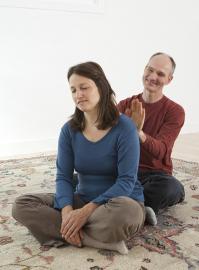
For a parent, being present with your child without any agenda, even for short periods of time, is essential to that child’s development as a happy, secure human being. For many parents of young children, this is more easily said than done—whether due to the demands of a job, or of running a household, or both. But there’s a simple practice for nourishing both ourselves and our children, one that doesn’t require special dexterity or a great deal of time, called Breema Bodywork.
Through the vehicle of touch, Breema brings about a harmonious state that’s comforting for both the giver and the receiver. Through its gentle, rocking movements, secure holds, and soothing strokes, the recipient comes to feel safe and relaxed. Rather than addressing specific ailments or conditions, Breema nourishes the whole person on many levels. Breema is guided and informed by nine universal principles, the Nine Principles of Harmony:
- Body Comfortable
- No Force
- Firmness and Gentleness
- No Judgment
- Single Moment/ Single Activity
- Mutual Support
- No Extra
- Full Participation
- No Hurry/No Pause
While holding or playing with a child, I can look for my own “Body Comfortable” way of moving. Asking myself, “How am I right now?” is what distinguishes Breema from other somatic work. I can assess whether the child is comfortable by seeing if my own body is comfortable. With this, I become available to what the moment requires.
In the Breema touch there is “No Force.” It is this gentle quality that allows the recipient to let go of fears and anxieties—often held unconsciously—that restrict blood flow and the natural breathing rhythm. An example of the “Firmness and Gentleness” principle is found in the way that we hold a baby: we hold firmly enough so he feels secure, but gently enough so as not to cause discomfort. Being connected to one’s body is what gives us the qualities of firmness and gentleness.
Or I might be cutting vegetables for dinner when my little one tries to talk with me. If I remember the principle of “Single Moment/Single Activity” I can turn toward the child, make eye contact, and engage, before returning to my task.
Touch is often conditional, communicating an expectation or a preconception that something is wrong. That’s why being touched with “No Judgment” can be so revolutionary. According to the Breema Center‘s director, Jon Schreiber, D.C., “In receiving Breema, many individuals experience being unconditionally accepted for the first time in their life.“
Although we tend to think of childhood as a carefree time before the demands of higher education and earning a living come to the fore, children feel many unspoken pressures from parents, teachers, and peers. So, for them, the Breema touch—without agenda—is supremely nurturing.
Since 1999, Breema instructor Birthe Kaarsholm has taught a course that she calls “Baby Moves” at the East Bay Waldorf School in El Sobrante, California, for children three months old through toddler age. In this weekly class, parents and infants come together in a way that exemplifies the Breema principle of “Mutual Support.”Parents get down on the floor with their young ones and mimic the developmental stages that take place during the first year of life: lying supine, creeping and crawling, rolling, sitting, standing upright, balancing . . . success!
Birthe reminds us that each new stimulation babies receive gets expressed through movement. We can easily observe that babies live in the present by how connected they are with their body. These littlest of teachers, with full concentration and ease of movement, point the way toward greater mobility and freedom of expression.
Receiving Breema from a certified practitioner, Kaarsholm affirms, can be wonderful for anyone, and especially for new parents as they adapt to the rhythms and needs of a baby in the home. It can
also be therapeutic for mothers and babies where there’s been a long labor or other complications during the birth process. While, in fact, Breema can help support digestive functioning and reduce colic, this gentle work does not set out to fix or address specific conditions.
We can come into our body simply by experiencing our weight as we sit or stand, or by observing the breath as we inhale and exhale, allowing it to have its own natural rhythm. Being attentive in this way gives us greater access to our common sense and intuition as we go about our daily activities.
The Breema Center was founded by Jon Schreiber, who, having completed his Doctor of Chiropractic degree, felt that a more holistic approach was needed to support and maintain vital energy in the body. In 1980, along with a core group of individuals, he began a search for that support, and today this bodywork system, with its practical tools for becoming more present and available to life, is taught worldwide.
A full Breema session usually lasts an hour or more, but even just practicing for several minutes is profoundly nurturing; no real dexterity is required. Self-Breema exercises are another aspect of Breema. These are simple movement sequences done for oneself, using the Breema Principles as a support for being present.
To get more acquainted with the Breema touch or to further explore the variety of sequences that exist in both Breema Bodywork and Self-Breema, the support of a qualified instructor is necessary. To learn about classes and practitioners near you, go to www.breema.com.
*Being Present with Children: The Breema Touch was written by And Gibb and originally published in Hearts At Play.